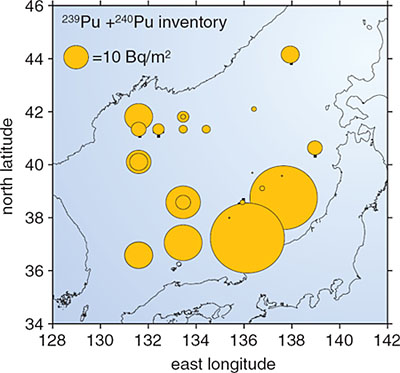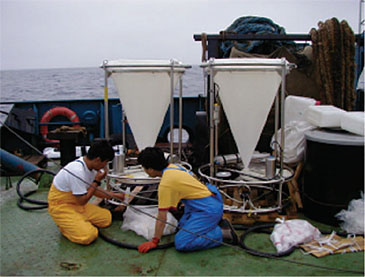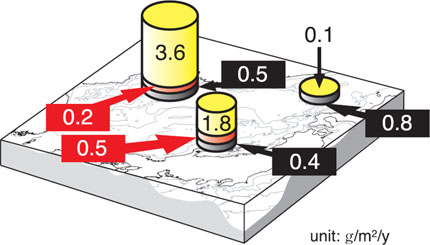9-2 |
Investigating the Origin of Seabed Materials |
 |
||
|
 |
||
|
 |
||
|
|
Understanding the radioecological processes in the Japan Sea (East Sea) is important for Far Eastern Countries because many nuclear facilities are located in the region surrounding the Japan Sea. Furthermore, the Japan Sea is regarded as a "miniature" of the ocean because of its bowl-like topography and unique seawater circulation. From 1997 to 2002, we conducted oceanographic observations in the Japanese and Russian exclusive economic zones in the Japan Sea. This clarified that the inventory of anthropogenic radionuclides in seabed sediment was greatest in the southeastern margin of the Japan Sea (Fig. 9-4). To clarify the transport process of particulate material, a sampling device called a "Sediment trap" (Fig. 9-5) was employed. Settling particles were collected in three regions in the Japan Sea. Using elemental composition of the settling particles, lithogenic aluminosilicates in the water column were classified into three transport processes (Fig. 9-6). In the western Japan Sea, more than 80% of lithogenic particles were estimated to originate through the atmosphere from the Asian Continent, partly as yellow dust (KOSA). In the eastern Japan Sea, it was suggested that a significant amount of lithogenic particles are supplied horizontally from the East China Sea and/or the islands of Japan. These findings enable us to understand that the supply of anthropogenic radionuclides to the deep parts of the Japan Sea is controlled not only by the fallout to the ocean surface but also by seawater movement and ocean topography. |
|
Reference
S. Otosaka et al., Lithogenic Flux in the Japan Sea Measured with Sediment Traps., Mar. Chem., 91 (1-4), 143 (2004). |
| Select a topic in left column |
|
|
Persistent Quest Research Activities 2005
Copyright (C) Japan Atomic Energy Research Institute |